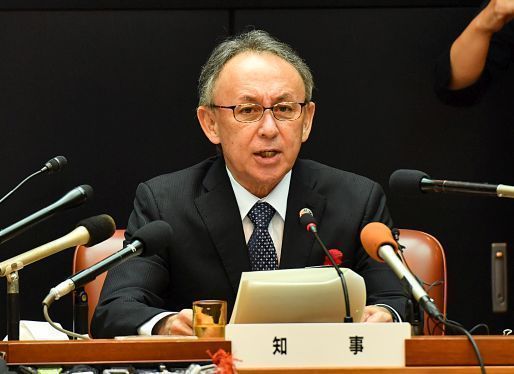OPG rejects FRF construction design changes due to deficiencies in soft seafloor investigation

Around 5:40 p.m. on November 25 at the Prefectural Office, Governor Denny Tamaki declares "rejection" of design changes (photograph courtesy of Hiroyuki Takatsuji)
November 26, 2021 Ryukyu Shimpo
On November 25, the Okinawa Prefectural Government (OPG) decided to reject the Okinawa Defense Bureau’s (ODB’s) design change application for soft seafloor improvement work pertaining to construction of the Futenma Replacement Facility in Henoko, Nago City. The OPG made this decision because of deficiencies in the investigation of the soft seafloor and because the measures for environmental conservation are inadequate. The OPG informed the ODB of its decision on the same day. On the evening of the same day, Governor Denny Tamaki held a press conference and stated that originally, the ODB “did not carry out the minimum level of geotechnical investigation necessary prior to starting in on the project, and plunged forward while there were still uncertainties involved.” He thinks that the entire scope of land reclamation, including the construction that is currently underway, should be suspended.
[Reasoning behind the rejection] Why use this “trump card” now?
Due to the OPG rejecting the design change, the ODB will not be able to carry out construction where the soft seafloor is present, which is on the Oura Bay side of the construction zone. It is likely that the ODB will take countermeasures such as making a formal objection based on the Administrative Appeal Act in order to nullify the OPG’s rejection. Thereafter, it is likely that the OPG will claim that these countermeasures are illegal, and a court battle will ensue.
According to the OPG, the written design change application does not make use of data obtained through the direct examination of the deepest point underwater of the soft seafloor in the ocean area planned for land reclamation, where the soft seafloor is approximately 90 meters underwater, and, as such, “no examination has carried out with adequate consideration to disaster prevention.”
Additionally, there has been no underwater sound investigation into the construction’s effects on the dugong, and, as such, the examination of environmental conservation measures has not been sufficient.
Governor Tamaki spoke about the use of soil from the southern part of Okinawa Island, in which the remains of war dead from the Battle of Okinawa may be present, saying, “There are many prefectural citizens and national citizens who feel apprehension, resentment, and sorrow due to land reclamation being forced through unilaterally and in a heavy-handed manner without an adequate explanation.”
Governor Tamaki also pointed out that if deficiencies in the investigations and procedures pursued by the ODB dramatically lengthen the construction period, land reclamation will become impossible to complete, and not only that, it has become impossible to avoid incurring enormous costs exceeding initial estimates.
According to the ODB, at 4:40 p.m. on November 25, it received written notice about the rejection from OPG personnel. When asked in an interview, a spokesperson for the ODB said that, “First, we will carefully examine the reasoning behind the rejection.”
(English translation by T&CT and Erin Jones)
Previous Article:“The Great Okinawa Trade Fair 2021,” one of Japan’s largest food industry events, took place for the first time in two years
Next Article:Vivid “Ryukyu Illustration” originating from Koza put on display for Japan
[Similar Articles]
- Soft seafloor precludes marine work yards for temporary caisson storage in FRF construction
- Central government considers Henoko seafloor reinforcement method using 60,000 sand pillars
- Ground reinforcement means initial sand needs for FRF increase 11-fold, cost rises to 150 billion yen
- OPG loses Henoko coral lawsuit with two of five judges holding a dissenting opinion
- Mega-float idea was not shared with Gov. Tamaki: “Conversation has gone back in time”
 Webcam(Kokusai Street)
Webcam(Kokusai Street)


